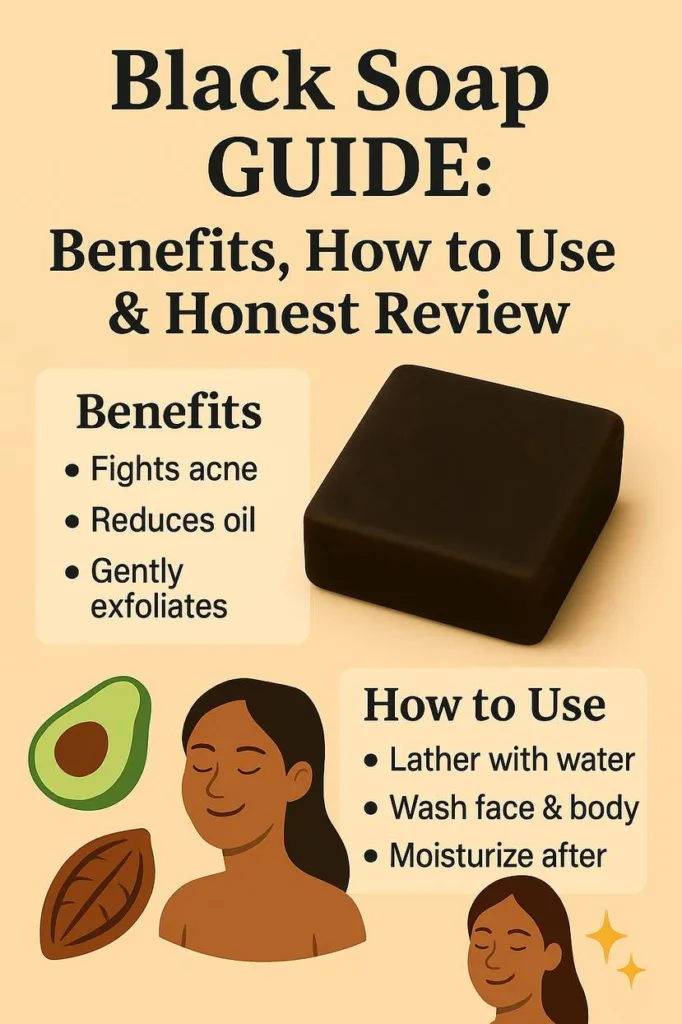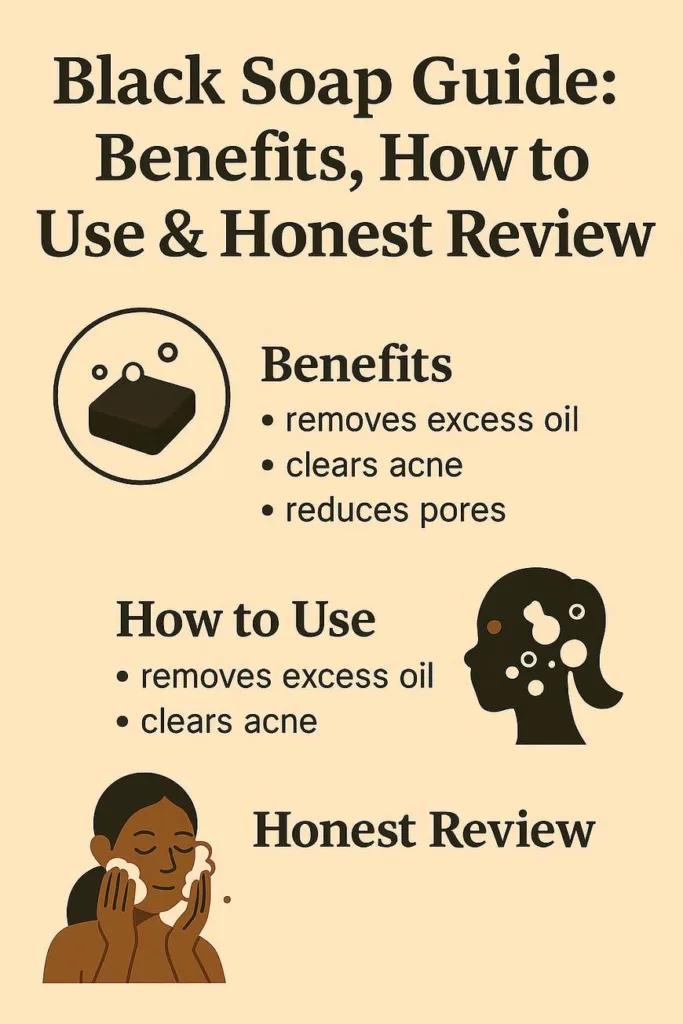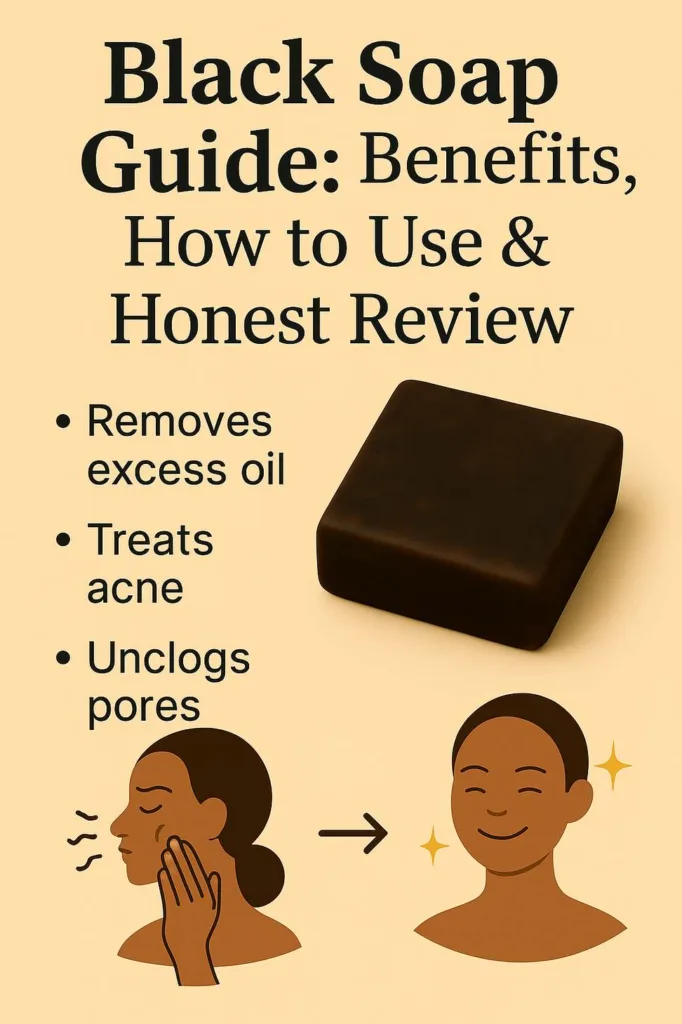When I first picked up a bar of black soap at a local market, I was skeptical. The rough, uneven texture and earthy smell were unlike any cleanser I’d used before. Two years later, it’s become a staple in my skincare routine—but only after learning some hard lessons about using it correctly. If you’re curious about this traditional West African cleanser but want the real story (not just the hype), this guide covers everything I wish someone had told me before I started.

What Is Black Soap?
Origin & Traditional Process
Black soap, known as “ose dudu” in Yoruba or “alata samina” in Hausa, originates from West Africa, particularly Ghana and Nigeria. Traditional artisans create it through a time-honored process that begins with burning plantain skins, cocoa pods, and palm kernel husks into ash. This nutrient-rich ash is then mixed with water and combined with natural oils like unrefined shea butter, coconut oil, and palm oil. The mixture is stirred by hand for hours until it reaches the proper consistency.
Ingredients You’ll Commonly See
Modern black soap bars typically contain plantain ash, palm kernel oil, coconut oil, and shea butter as primary ingredients. Look for products labeled “unscented” or “raw” if you want the traditional experience. Many fair-trade versions support West African cooperatives directly, ensuring authentic production methods and fair compensation for artisan communities.
What Makes It ‘Black’
The distinctive dark color comes from the ash content, not artificial dyes. Authentic black soap can range from deep brown to charcoal gray, with natural variations in texture and color intensity depending on the ash concentration and oils used.
Why People Swear by It (Benefits)
For Oily/Combination Skin
Black soap’s natural alkalinity and gentle abrasive texture make it effective for oily and combination skin types. The plantain ash provides mild exfoliation that helps unclog pores without the harshness of synthetic scrubs. Many users report that their skin feels deeply clean without being stripped.
Body Use vs. Face Use
While black soap works well on the body for most people, facial use requires more caution. The texture can be rougher than typical facial cleansers, and the higher pH may be too intense for delicate facial skin. I personally use it on my body regularly but limit facial use to 2-3 times per week.
Scalp & Body Acne Anecdotes
Some people find black soap helpful for scalp buildup and body acne, particularly on the back and chest. The clarifying properties may help remove excess oils and dead skin cells, though results vary significantly between individuals.
My first week with black soap was enlightening. The initial scent—earthy and slightly smoky—took getting used to. My skin felt squeaky clean but uncomfortably tight afterward. By week two, once I adjusted my routine and started moisturizing immediately, I noticed my skin looked brighter and felt smoother.
My Experience: The Good, the Awkward, the Results

The Learning Curve
My biggest mistake was treating black soap like a regular bar soap. I scrubbed for too long, used hot water, and skipped moisturizer—resulting in uncomfortably dry, tight skin. It took about three weeks of experimenting to find the right approach.
What Actually Worked
The game-changer was keeping contact time short (30-60 seconds maximum), using lukewarm water, and applying moisturizer while my skin was still damp. I also switched to every-other-day use instead of daily, which prevented over-cleansing.
Before/After Vibe (No Miracle Claims)
After three months of proper use, my skin texture improved noticeably. The rough patches on my upper arms softened, and my occasional body breakouts became less frequent. However, it wasn’t a dramatic transformation—more like a gradual improvement in overall skin clarity and smoothness.
Who Should (and Shouldn’t) Use It
Skin Types That Often Like It
Black soap works particularly well for people with oily or combination skin who can tolerate a higher pH cleanser. Those dealing with keratosis pilaris (rough, bumpy patches on arms or thighs) often see improvement with regular use.
Proceed with Caution
If you have very dry skin, active eczema, or a compromised skin barrier, black soap may be too harsh. The alkaline nature can disrupt the skin’s natural pH balance, potentially worsening existing irritation.
Patch Test Protocol
Always test black soap on a small area first. Apply a small amount to your inner wrist or behind your ear, leave for 60 seconds, rinse thoroughly, and wait 24 hours. If you experience redness, burning, or persistent irritation, discontinue use.
How to Use Black Soap the Right Way
Face Routine (30-60 Sec Max Contact, Lukewarm Water, Moisturize)
Create a gentle lather with lukewarm water and apply to damp skin using light, circular motions. Limit contact time to 30-60 seconds maximum, then rinse thoroughly. Follow immediately with a hydrating moisturizer or serum to restore the skin barrier.
Body Routine (Lather on Sponge, Rinse Thoroughly, Seal with Lotion/Oil)
For body use, work the soap into a lather using a soft sponge or washcloth rather than applying the bar directly to skin. This creates a gentler cleansing experience and helps the bar last longer. Rinse thoroughly and apply body lotion or oil while skin is still damp.
Frequency & Pairing
Start with 2-3 times per week and adjust based on your skin’s response. Avoid using strong acids or retinoids on the same evening, as the combination may cause excessive dryness or irritation.
Storage Tips
Keep your bar in a well-drained soap dish and allow it to dry completely between uses. Consider cutting larger bars into smaller chunks to prevent waste, as wet black soap can become mushy and dissolve quickly.
Black Soap vs. Charcoal Soap (Not the Same Thing)
Ingredient Differences
While both appear dark, black soap gets its color from plantain ash, whereas charcoal soap contains added activated charcoal. Black soap is traditionally alkaline due to the ash content, while charcoal soap formulations vary widely by brand.
Feel & Results
Black soap typically has a more rustic texture and higher pH, creating that characteristic “squeaky clean” feeling. Charcoal soaps often feel more like conventional cleansers with added detoxifying claims.
Which One I Reach For and When
I prefer black soap during humid summer months when my skin produces more oil, and switch to milder charcoal soaps during dry winter weather when my skin needs gentler treatment.
Buying Guide: What to Look For
“Raw” vs. Refined Bars
Raw black soap maintains its traditional bumpy, uneven texture and may contain visible plant matter. Refined versions are smoother and often gentler, but may contain additional ingredients that alter the traditional formulation.
Short Ingredient Lists
Choose bars with minimal ingredients—ideally just the traditional oils, ash, and water. Avoid products with heavy fragrances, artificial colors, or long lists of chemical additives that mask the soap’s natural properties.
Fair-Trade & Authentic Sourcing
Supporting fair-trade cooperatives ensures you’re getting authentic products while contributing to sustainable livelihoods in West Africa. Look for certifications or clear sourcing information from reputable suppliers.
Travel/Gel Versions
Liquid black soap offers convenience and controlled application but may contain additional preservatives or diluting ingredients. Bar soap provides the most authentic experience but requires proper storage and handling.
Common Mistakes & How I Fixed Them
Using It Like a Harsh Scrub
Initially, I rubbed the bar directly on my skin with significant pressure. The solution was whipping it into a soft, creamy lather first and using gentle circular motions instead of aggressive scrubbing.
Skipping Moisturizer
The tight, dry feeling after cleansing tempted me to skip moisturizer, thinking my skin was “clean enough.” Adding a humectant-rich moisturizer with ceramides immediately after cleansing transformed my experience entirely.
Daily Use Too Soon
Starting with daily use led to over-cleansing and irritation. Reducing to 2-3 times per week initially, then gradually increasing frequency based on my skin’s tolerance, proved much more effective.
FAQs
Is black soap good for acne? Some people find it helpful for body acne due to its clarifying properties, but it’s not a targeted acne treatment. Consult a dermatologist for persistent acne concerns.
Can I use it every day? Most people should start with 2-3 times per week and adjust based on skin tolerance. Daily use may be too drying for many.
Why does my skin feel tight after? The alkaline nature temporarily disrupts your skin’s pH balance. This feeling should subside after moisturizing and typically improves as your skin adjusts.
Can sensitive skin use it? Proceed with extreme caution. The high pH and exfoliating properties may be too harsh for sensitive skin types.
Does black soap lighten skin? Black soap may help with evening skin tone through gentle exfoliation, but it’s not a skin lightening product and shouldn’t be used with that expectation.
How long does a bar last? With proper storage and moderate use, a typical bar lasts 2-3 months for one person using it 2-3 times weekly.
Can I use it on my hair/scalp? Some people use it as a clarifying shampoo occasionally, but it can be drying. Always follow with a good conditioner.

Final Thoughts & Next Steps
Who I’d Recommend It To
Black soap works best for people with oily or normal skin who enjoy traditional, minimalist skincare approaches. It’s particularly appealing if you prefer products with short ingredient lists and cultural heritage.
Simple Starter Routine
Begin with 2-3 uses per week on your body, creating a gentle lather and moisturizing immediately afterward. If your skin tolerates it well, you might experiment with occasional facial use, always following with hydrating products.
When to Stop or Switch
Discontinue use if you experience persistent irritation, excessive dryness, or worsening skin conditions. Black soap isn’t for everyone, and there’s no shame in finding it’s not right for your skin. The goal is healthy, comfortable skin, not adhering to any particular product or routine.
Remember, skincare is highly individual. What works wonderfully for one person may be completely wrong for another, and that’s perfectly normal. Start slowly, listen to your skin, and adjust accordingly.